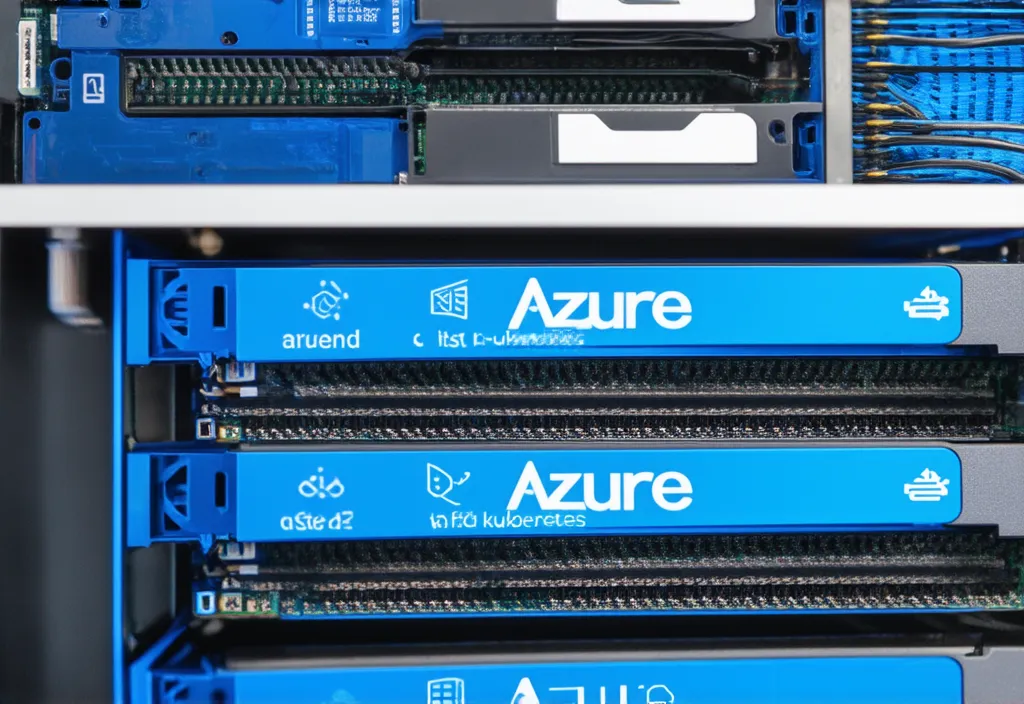Cloud Computing - Azure
Azure Kubernetes Service Best Practices: Master the Art of Container Orchestration with Azure Kubernetes Service
 Quest Lab Team
Quest Lab Team
With cloud adoption soaring, container orchestration has emerged as a key practice in modern development. Among the leading tools, Azure Kubernetes Service (AKS) has solidified its place as a powerful, enterprise-ready platform for managing containerized applications at scale. This article dives deep into the essential best practices for mastering AKS, offering practical tips and advanced strategies to maximize performance, security, and cost-efficiency.
Managed by Microsoft, AKS simplifies Kubernetes deployment by offering automatic scaling, monitoring, and management features. In recent years, AKS has seen significant improvements and new features aimed at enhancing the developer experience while ensuring robust security and high availability. This guide provides a comprehensive look at implementing AKS in a way that aligns with enterprise best practices, from cluster setup to security configurations and monitoring frameworks.
Introduction to Azure Kubernetes Service (AKS)
Azure Kubernetes Service (AKS) is a fully managed container orchestration service that leverages Kubernetes, an open-source platform for automating the deployment, scaling, and management of applications. Introduced by Microsoft in 2018, AKS has rapidly become a popular choice for organizations looking to adopt microservices architecture, continuous integration, and continuous delivery (CI/CD), as well as cloud-native development. AKS enables businesses to deploy and manage containerized applications without the overhead of complex infrastructure management, making it ideal for organizations looking to scale efficiently.
"The need for efficient container orchestration in enterprise applications has spurred the rapid adoption of Kubernetes, with Azure Kubernetes Service at the forefront of managed solutions."
Core Benefits of Using AKS
- High Availability: AKS offers multiple options for configuring high availability, with automatic failover and self-healing capabilities.
- Scalability: Built-in scaling options allow applications to scale up and down based on demand, optimizing resources and reducing costs.
- Security: With Azure’s security protocols, AKS provides enhanced security features such as role-based access control (RBAC) and network policies.
- Cost-Effectiveness: As a fully managed service, AKS reduces the operational costs associated with running Kubernetes clusters.
For businesses, AKS represents an opportunity to leverage Kubernetes without the associated complexity of managing the infrastructure, ensuring applications can be scaled and secured efficiently. Understanding the fundamentals of AKS and implementing best practices around these benefits is essential for a successful deployment.
Best Practices for Setting Up AKS Clusters
Setting up a Kubernetes cluster in AKS requires careful consideration of the underlying architecture. Below, we explore key steps in designing an efficient and scalable AKS setup.
1. Choosing the Right Node Size and Type
Node selection is a fundamental part of configuring AKS. For optimal performance, it's important to select node sizes that align with your application’s requirements. Use a combination of general-purpose, memory-optimized, or GPU-enabled nodes based on workloads, with attention to cost-performance balance.
2. Configuring Node Pools
AKS allows for the creation of multiple node pools, enabling the segregation of workloads based on their requirements. For instance, production and development workloads can be isolated within their respective node pools, improving resource management and cost allocation.
3. Enabling Cluster Autoscaler
The Cluster Autoscaler feature in AKS adjusts the number of nodes in response to workload demands, allowing efficient resource management. This is especially useful for businesses with varying levels of demand, as it enables cost-effective scaling without manual intervention.
Security Best Practices in AKS
Security is a major concern for AKS users, as vulnerabilities can compromise both the cluster and application data. Following security best practices is vital to protect workloads against attacks and ensure data integrity.
4. Role-Based Access Control (RBAC)
Implementing RBAC in AKS is essential for controlling user access to resources. By assigning roles based on job functions, RBAC minimizes unauthorized access, ensuring users have only the permissions necessary to complete their tasks.
5. Network Policies
AKS allows the configuration of network policies to restrict communication between pods, mitigating the risk of malicious lateral movement within the cluster. Network policies should be designed to follow the principle of least privilege, restricting pod-to-pod communication as necessary.
Pro Tip for Enhancing AKS Security
Leverage Azure Active Directory integration for unified identity management. This enhances security by enforcing centralized authentication and user identity management for AKS.
- Use multi-factor authentication (MFA) to add an extra layer of security for user logins.
- Implement Azure AD groups for streamlined access control within AKS clusters.
Monitoring and Logging in AKS
Effective monitoring and logging practices in AKS provide insights into application performance and cluster health, enabling proactive management. Azure Monitor and Log Analytics offer robust monitoring capabilities tailored for AKS.
6. Implementing Azure Monitor for AKS
Azure Monitor provides real-time insights into AKS cluster performance, helping teams detect and troubleshoot issues efficiently. Monitoring metrics like CPU and memory utilization are crucial for optimizing resources and preventing performance bottlenecks.
7. Configuring Log Analytics
Log Analytics in AKS collects logs from the cluster, offering visibility into application events and cluster activities. By setting up custom alerts and queries, teams can monitor critical activities and respond swiftly to incidents.
- Pro Tip: Configure alerts in Azure Monitor to notify teams of unusual events, such as high resource usage or network anomalies, to ensure quick remediation.
Cost Optimization Strategies for AKS
Managing costs effectively is crucial in AKS, as Kubernetes can incur high expenses without proper resource management. Below are some strategies to optimize AKS costs without compromising performance.
8. Right-Sizing Resources
Ensure that nodes and pods are correctly sized to avoid over-provisioning. Using resource requests and limits for each pod helps manage utilization and prevents resource wastage.
9. Implementing Spot Instances
Spot instances in AKS offer significant cost savings for non-critical workloads by utilizing unused Azure capacity. This is an effective way to run batch jobs or non-mission-critical workloads at a reduced cost.
By following these best practices, organizations can fully leverage the capabilities of Azure Kubernetes Service, from enhanced security and scalability to cost savings and operational efficiency. AKS offers a scalable, secure, and cost-effective solution for businesses looking to deploy Kubernetes in the cloud with confidence.
As businesses embrace cloud-first strategies, Kubernetes has become the backbone of scalable, containerized applications. Azure Kubernetes Service (AKS), backed by Microsoft, has surged in popularity as an enterprise solution for managing Kubernetes with ease. This guide provides the essential strategies and research-backed insights needed to maximize AKS, helping your organization harness its full potential.
Why AKS? Evidence of Industry Shift
A recent study by Gartner projected that by 2025, over 85% of enterprises will be running containerized applications in production environments. Azure Kubernetes Service, introduced by Microsoft in 2018, is now widely adopted by enterprises aiming to modernize applications while maintaining cloud-native benefits. The rise of AKS can be attributed to its managed infrastructure, cost-effectiveness, and deep integration with Azure’s security and compliance protocols.
AKS Performance Optimization Techniques
Optimizing AKS performance ensures your applications remain responsive, even under high load. Below, we explore proven techniques for fine-tuning AKS for both efficiency and scalability.
10. Configuring Horizontal Pod Autoscaler
The Horizontal Pod Autoscaler (HPA) in AKS enables automatic scaling of pods based on CPU utilization or other application metrics. This ensures that your applications remain resilient under varying load conditions, automatically scaling up or down as needed.
11. Optimizing Node and Pod Resource Allocation
Resource allocation in Kubernetes ensures that each application has access to the necessary CPU and memory. Implementing resource requests and limits in AKS is crucial for preventing resource contention and maintaining cluster health.
Security Enhancements for Enterprise AKS Deployments
With increasing security threats, adopting a layered security approach in AKS is essential. Security best practices span from access control to network isolation, each reinforcing the resilience of the cluster. Here are advanced security tactics for AKS implementations.
12. Implementing Azure Policy for AKS
Azure Policy enables you to enforce rules across AKS clusters, helping to ensure compliance with organizational standards. With Azure Policy, administrators can restrict specific container privileges, enforce network isolation, and automatically audit changes.
13. Hardening Network Security with Private Endpoints
Configuring private endpoints in AKS ensures secure communication within the Azure network, reducing exposure to the public internet. This minimizes attack vectors and enhances security, particularly for sensitive workloads.
"In 2023, 60% of AKS-related security incidents were linked to misconfigured network policies. Establishing private endpoints mitigates these risks by securing traffic within trusted boundaries."
Advanced Monitoring and Observability in AKS
Monitoring AKS clusters is vital for maintaining application performance and identifying issues before they impact users. Azure provides several tools to enhance observability, ensuring comprehensive visibility across your AKS environment.
14. Enabling Container Insights in Azure Monitor
Azure Monitor’s Container Insights provides real-time monitoring of AKS nodes and pods. This service collects metrics like CPU, memory usage, and network performance, enabling proactive performance management.
15. Log Management with Azure Log Analytics
Azure Log Analytics captures a comprehensive log of activities within the AKS cluster. By configuring custom alerts, you can identify and respond to anomalous events quickly, minimizing downtime and securing cluster integrity.
Implementing CI/CD Pipelines with AKS
Continuous integration and continuous delivery (CI/CD) pipelines streamline AKS deployments, ensuring that updates reach production smoothly. Using tools like GitHub Actions or Azure DevOps, you can automate deployments and maintain application reliability.
16. Automating AKS Deployments with Azure DevOps
Azure DevOps supports AKS deployments with predefined build and release pipelines. This allows teams to automate Kubernetes deployment, reducing manual intervention and minimizing errors.
17. Integrating GitHub Actions for CI/CD in AKS
GitHub Actions offers a flexible way to build and deploy applications to AKS. By configuring workflows, you can automate the deployment process, ensuring updates are reliably pushed to production.
Data Backup and Disaster Recovery in AKS
Data backup and disaster recovery are essential for minimizing the impact of incidents. By implementing robust backup and restore strategies in AKS, you can ensure data continuity and protect against unexpected failures.
18. Configuring Persistent Volume Backups
AKS supports persistent storage using Azure Disk and Azure File. Regular backups of persistent volumes can be managed with automated snapshots, providing a safeguard against data loss.
19. Setting Up Disaster Recovery Plans with Velero
Velero, an open-source tool for Kubernetes, provides backup and disaster recovery capabilities. By configuring Velero with AKS, you can automate the backup of resources and persist data in the event of a cluster failure.

Quest Lab Writer Team
This article was made live by Quest Lab Team of writers and expertise in field of searching and exploring
rich technological content on cloud computing and its future with its impact on the modern world



